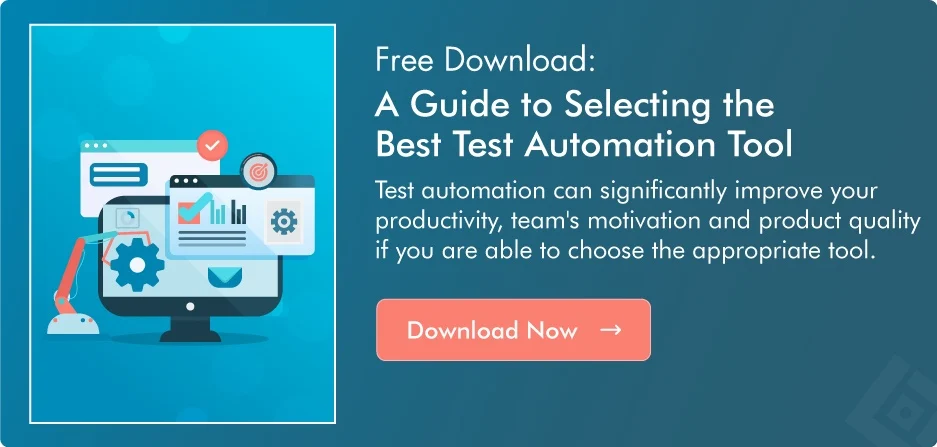
DevOps does more than enhance your product’s visibility and compliance - it creates a culture of trust and certitude among Dev and QA teams.
Implementing DevOps in your product development strategy can result in some serious financial benefits, due to increased collaboration and streamlined processes.
The primary goal of DevOps test automation is to release a product more quickly and with better quality. Tech giants such as Google, Amazon, and Netflix are among a few that have leveraged this fast-moving technology, and it’s time you do it too.
DevOps works on the ‘fail fast, fail often’ philosophy that is backed up by a ‘test first’ mentality. As a result, testing becomes continuous which may increase the need for automation.

How Easy Is It to Implement a Devops Test Automation Strategy?
If you’re a DevOps-centric organization, or plan to be one, you need to find ways to segregate the testing process among your Dev and QA team. You need sustained testing at every stage of your product development, and even delivery, to ensure that testing takes less time while still uncovering the bottlenecks.
Your Continuous Testing Roadmap
Continuous testing for DevOps involves a combination of tasks and tools that enable you to find more incremental bugs and errors per unit time, which allows you to fix small bugs before their severity increases.
-
Continuous Integration
Your Dev team should upload code to a shared repository on a multiple-times-a-day basis. The DevOps-driven QA team then performs automated build testing to flag the bugs before they sneak out from the staging environment and into production. -
Unit Testing
Unit testing will let you detect more errors early, facilitate change, create a documentation source, and ensure that different units of source code perform well individually. -
Performance Testing
It will enable you to measure the speed, credibility, as well as product uptime. Performance testing also measures the critical performance metrics of your application including APIs and DB queries in order to detect any performance degradation or stability issues on a regular basis. -
Integration and Functional Testing
Integration testing combines similar elements of your application where they are tested together. This is complemented with functional testing, where features of your app are tested against the expectations and specifications. -
Acceptance Testing
This ensures the application is compliant with the business requisites. A key benefit of acceptance testing is transparency - you are clear about the deployed features that are behaving as expected and the ones that are not. It is more of a communication bearer as acceptance testing includes test execution, report sharing, and communication. -
Smoke Testing
During smoke testing, your QA team analyzes the key elements and then tests them. Continuous smoke testing of the critical sections of the application will ensure a high level of product quality. -
Chaos Testing
Your QA team injects chaos into staging and production environments - this reveals how your system will behave against unknown factors and stress. Chaos testing can expose bottlenecks in infrastructure that might have gone unnoticed. Regular stress testing and chaos engineering also prepare your team for real incidents when they happen in your production environments. -
Continuous Delivery
Continuous testing is followed by continuous delivery. When you are assured that the code works when integrated into a shared repository without any interruption, you ship to production more often and with fewer bugs. By implementing the best practices of automation testing for DevOps, throughout all stages of the product development and release lifecycle, your business can deliver value to customers at regular intervals.
Pro Tip: Keep Track of the Long Tests
Your QA team would often leave short tests unattended - these run as a part of the CI cycle. In case these tests fail, say due to false positive issues, the drawbacks may be minimal.
However, in the case of long tests, failure in tests means a dent in overall productivity. To avoid loss of time and money, you should attend the real-time monitoring of tests. While the tests run, watch out for signs that indicate any threats to product failure within the environment or scripts.
You can stop the test and have your QA team look at it. Tools like Ranorex and SoapUI provide you with test monitoring features. You can compare different reports that offer live test data and can make updates in the test.
DevOps enables you to streamline the collaboration between your Dev and QA teams. There is transparency in the development, deployment, and operations processes and every task is considered as a candidate for automation.
Adopting DevOps is your first big step towards staying ahead of the curve in this cut-throat competitive environment.
If you are struggling with keeping up with the DevOps best practices and need a dedicated partner that can assist you up your DevOps game, visit qasource.com/devops or speak to a specialist today.






